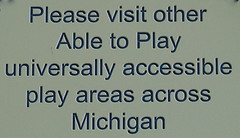Two of them were accessible. The photos that I took of the play areas didn't turn out, but they both had a ramp that allowed access to the play structure (the towers, steering wheels, and other toys on the walls of the enclosure, as well as the tops of the slides and stairs). The play area in Michigan also had an English alphabet panel. With each letter was the American Sign Language hand gesture and the Braille character.
"Access to Play Areas" lists a variety of reasons to make play areas accessible.
A playground should not just be accessible for children. It should be accessible for adults with disabilities as well. At times there may be teachers, parents, or even grandparents at the play area that may have disabilities and need to access different elements of the play area should children using the equipment need support, supervision, or first aid.
Most importantly, an accessible play environment allows for social integration to still take place. Children naturally form play groups. Play areas that are inaccessible prohibit children with disabilities from fully participating in the group.
Once again, accessible design benefits a variety of users and strengthens our social fabric.

